A collection of beautiful vintage birds nest and egg illustrations by “the other Audubon“, Genevieve Jones.
All of these wonderful vintage prints are from the book “Illustrations of the Nests and Eggs of Birds of Ohio“. The book was published in two volumes, the first of which was started by Genevieve Jones in 1877. Unfortunately, she died of typhoid in 1879 before completing the book.
Genevieve Jones and The of Birds Nests of Ohio
Genevieve Jones (1847 -1879) was a self-taught amateur naturalist and scientific artist. Her interest in ornithology was sparked by her father. She would accompany him on his doctor rounds in Ohio. On these trips, they would collect birds’ nests and eggs for their curio cabinet.
But Genevieve got the idea for her book after seeing one of the exquisite Audubon’s hand-coloured engravings from The Birds of America at an exhibition in 1876.
Impressed by Audubon’s bird illustrations, but disappointed by the fact eggs and nests weren’t given much thought, Genevieve sought to rectify that with her book.
Her family and friends were happy to help and support Genevieve as they thought it would help her get over heartbreak and a broken engagement.
Genevieve died, after only completing five of the illustrations. Her family then took over the completion of the book. Virginia, her mother taught herself scientific illustration. Her father Dr Howard Jones wrote the text and collected the bird nests and egg specimens. The book was finally completed in 1886.
Printing the Birds Nest and Egg Illustrations
Click on the title above the print that you want to download, a higher resolution image will open in a new window on your device. If you then right-click on that image, you will have to option to print and save it.
All the prints are in the Public Domain.
1. Baltimore Oriole Birds Nest and Eggs
The Baltimore oriole is found in North East United States and is the state bird of Maryland. It is also the namesake and mascot for the Baltimore Orioles baseball team.
“The Baltimore Oriole arrives in Ohio between the middle of April and the first of May. A fortnight later the bird can be seen busily engaged in the construction of the nest.” They lay between 4 to six eggs.
“In the woods, long grasses, strips of bark and vegetable fibres of different kinds make up the structure; but in cities and villages, or in the country, near houses, yarn, wrapping-twine, horse and cow hairs, rags, paper and such other substances as are ready prepared and accessible, are largely used.”
2. Wood Thrush Nest With Eggs
The wood thrush is an American songbird considered to have one of the most beautiful songs. And is the official bird of the District of Columbia.
“The plate represents a nest of the average size, and materials of construction, as they occur in Central Ohio. It was taken on the 30th of May, 1877, from a haw tree, in a damp wood without much undergrowth. The light fluffy leaves of the foundation, the mossy branches and emerald foliage, the boggy earth and rank grass beneath, together formed a picture beautiful and rustic, a fitting symbol of the quiet wood, the drear repose in which this brilliant songster so many delights.“
3. Black Billed Cuckoo
“The nest figured was taken on May 21st, 1878, from a thicket overgrown with climbing vines, in a low piece of woods near the Scioto River, Pickaway county. It was placed about seven feet from the ground, supported by the dead branches of a thorn tree, together with the stems of ivy which climbed about the tree.“
4. Indigobird
Birds nest illustrations for the Indigobird.
“The nest illustrated was taken on the 28th of May, 1877, from an elder bush. The foundation consists of pieces of leaves and corn husks, mixed with rootlets, weed stems, and grasses; the super-structure is similar, but with finer rootlets about the rim. The lining is composed of about equal proportions of split grasses, fine bits of roller-grass, and black horse hairs; cobwebs are attached at irregular distances to the exterior, and seem to be used more for ornament than for any additional strength they may give to the structure.“
5. Red-Winged Blackbird
“The nest illustrated was taken on the 10th of May, 1877, from a swamp in Pickaway county. It is of the average size and composed principally of dried grasses and strips of flag leaves, lined with round grass and a few black horse hairs. The eggs figured were selected from a large number, and- represent the average and extremes in size and markings. The coloring is done from freshly blown specimens.“
6. Kingbird
“The nest represented in the drawing was taken in June 1877, from a sycamore growing on the bank of the canal in the southern part of Pickaway county; it was distant from the nearest farmhouse about three-quarters of a mile.”
7. American Robin
The American Robin is named after the European robin because of its reddish-orange breast, though the two species are not closely related.
“The nest illustrated was taken on the 19th of May, 1879, from a small elm tree growing in a field near a road. It represents the ordinary position, size, and materials of construction; the foundation contains but little material, this consists of weed-stems and mud; the superstructure is composed of finer weed stems, fibres, grasses, a few chicken-feathers, and the usual plaster of mud; the lining is of blades of grass, which are very unevenly distributed.“
8. Great Carolina Wren
“The nest from which the drawing was made was found on the 19th of May, 1879; it contained six eggs nearly hatched. It was built in a box nailed against the inside of an old barn and used only a short time before as a hen’s nest. When taken possession of by the Wren, the box was nearly full of straw and grass. In this, near one corner, a cavity was made to receive the nest. The illustration shows the nest as it was lifted from the cavity, some of the grasses still hanging to it.”
9. Eastern Bluebird Nest
The eastern bluebird is a small North American migratory thrush found in open woodlands, farmlands, and orchards. It is the state bird of both Missouri and New York.
“The nest represented by the plate was found the first of April. It was built in an old black-walnut stump, in a wheat field. The part containing the nest was sawed-off below, and split-open so as to give a clear side view of the structure, which was composed of blades of grass, and contained live eggs. The entrance to the cavity was from above, and was distant from the ground about two feet.“
10. Barn Swallow
The barn swallow is the most widespread species of swallow in the world. It’s the national bird of Austria and Estonia.
“The birds’ nest illustration represents the average size and usual form of construction of the nest. It was built the third week in May 1878, against a rafter in an old scale house. The eggs figured show the average and two extremes in size and markings most commonly met with“
11. Summer Warbler
“To me, the nest of the Summer Warbler has always been a subject of admiration. It is the representative of strength, comfort, beauty, everything necessary for a cozy summer home; so compact is it, that it may be seen firmly attached to its supports after the frosts and winds of fall have stripped the foliage from the trees, and even the rains, snows, and gales of severe winter often fail to dislodge it.“
12. Field Sparrow
“The birds nest illustration was made from a nest taken June 3rd, 1879, in a wild rose bush. It fairly represents the usual size, materials, and position. The foundation consists of weed-stalks and a few straws; the superstructure of finer weed stems, fibres, and split grasses; the lining of horse-hair and roller-grass. The eggs figured show the usual sizes, shades of ground color, and markings.
13. Catbird
So called catbirds because of their wailing calls, which resemble a cat’s meowing.
“The cry of the bird is so like the animal after which it is named, that the association is not at all calculated to give it character; and where the Catbird is most observed during the nesting-season the Blue Jay is so abundant that I am inclined to the opinion that the sins of the latter have been shouldered upon the former. That the Catbird frequents the cherry trees and berry bushes and uninvited helps himself to the fruit, can not be denied, nor can it be gainsaid that this loss is more than compensated by the number of worms and insects destroyed.“
14. Cardinal Redbird
“The illustration was drawn from a nest taken May 20, 1880, from a low branch of a young haw tree. It represents the average nest in size, position, and materials of construction. The eggs show the usual sizes, shapes, and markings.”
15. Warbling and Red Eyed Vireo Birds Nest Illustrations
“Plate XXIII, fig. 1, illustrates a nest taken the twentieth of May, 1877, from a silver-poplar, standing beside a country road. It was near the extremity of a limb, about thirty feet from the ground. It contained four fresh eggs. The foundation of this nest is composed of flaxen fibres and grasses; the superstructure, of fibres, grasses, bits of decayed weeds, and a downy substance from the poplar; the lining is made entirely of roller-grass.“
“The second birds nest illustration was taken the second of June, 1880. It was situated at the extremity of an oak branch, seven feet from the ground. The exterior is composed of pieces of hornet’s nest, strips of the inner bark of trees and plants, shreds of the inner bark of the wild grape-vine, and bits of the web. The hornet-paper is bound tightly with flaxen shreds, frequently a stitch is taken in it, as shown in the large piece in front. The interior is composed entirely of long shreds of the inner bark of the grapevine.”
16. Carolina Dove
More commonly known as the Turtle Dove, it is one of the most abundant and widespread of all North American birds and a popular gamebird, with more than 20 million birds (up to 70 million in some years) shot annually in the U.S., both for sport and meat.
“The nest illustrated was selected on account of the simplicity of its surroundings. It is a compact and elaborate structure, but no more so than is necessary for security. The position in which it is placed requires more material and better workmanship than if it had been situated upon a large limb. It is composed of twigs, roots, weed stems, and straws; the upper surface is made up of the same but finer material than the base.”
17. Black-Throated Bunting
“The nest, when in a bush or tree, is easily discovered, as but little effort at concealment seems to be attempted; indeed, it is an impossible task to hide so large a structure in such situations as are generally chosen. The female is not often seen, as she slips from the nest to the grass at the approach of danger. Sometimes, however, she may be observed sitting, if caution is exercised. While the nest is being; robbed, neither the male nor the female makes the least demonstration.“
18. Hummingbird and Gnatcatcher Birds Nest Illustrations
“The first nest illustrated was taken from the limb of an apple tree near Gambier, in June 1879. It contained two fresh eggs. It is a beautiful specimen of Hummingbird architecture. The two eggs figured represent the usual sizes and shapes.”
Gnatcatcher Nest
“It has been suggested, that this nest is covered with lichens that it may appear like a natural woody
excrescence, and thus, ‘by deluding enemies the safety of its contents is greatly increased. This may be
the fact, but I receive the statement with doubt. The lichens and web make such a secure sheath about the walls, that these nests owe much of their strength and firmness to them. I can conceive of nothing better calculated to preserve the shape, to keep the walls dry, and at the same time give strength and
lightness, than a lichen covering as found upon this nest and that of the Hummingbird.“
19. Chipping Sparrow
The chipping sparrow is widespread, fairly tame, and common across most of North America.
“The illustration represents a nest built in an apple tree, June 1878. The nearest house was distant from the tree about half a mile. The foundation and superstructure are composed of fine rootlets, weed- stems, fibres, and slender grasses. The lining of fine weed stems, cow hair, and long, black horse hairs. The cavity measures one and three-fourths inches in diameter, by one and three-eighths inches in depth. The eggs figured represent the average and extremes in size, ground color, and markings.”
20. Purple Martin
The purple martin is the largest swallow in North America, known for its speed, agility, and characteristic mix of rapid flapping and gliding flight patterns. When approaching their nesting site, they will dive from the sky at great speeds with their wings tucked.
“Plate XXVIII illustrates an old-fashioned Martin-box, with its female occupant. The house is such as was formerly erected at nearly every cabin, and such as is still to be seen in certain sections of the State. Now, boxes are generally made, representing dwelling-houses, churches, or court-houses. These are often handsomely painted, and placed upon posts or house-tops; but I doubt if they are any more acceptable to the birds than the old-time gourd, with a hole cut in the side for an entrance, and a piece of branch driven in just beneath it for a perch, tied to a long pole set in the ground, or fastened in an upright position to a fence or gatepost.”
I hope you enjoyed these beautiful birds’ nest illustrations sampled from the Birds of Ohio book, first started by Genevieve Jones and then later finished by her family. Don’t forget to check out the other wonderful vintage bird illustrations on the site, including this collection of feather illustrations.
There are more egg illustrations in the Adlophe Millot Natural history poster collection and in these vintage nature posters of Oliver Goldsmith.
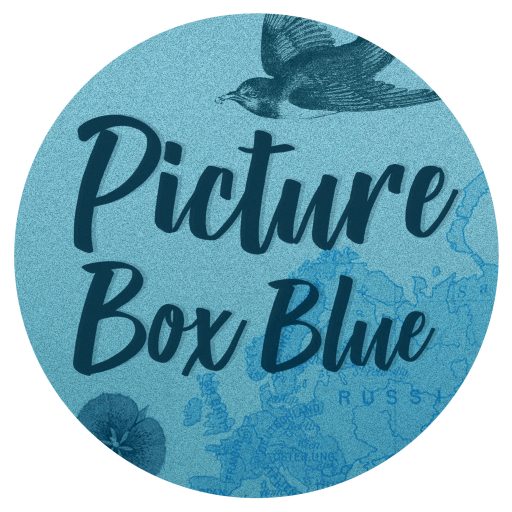
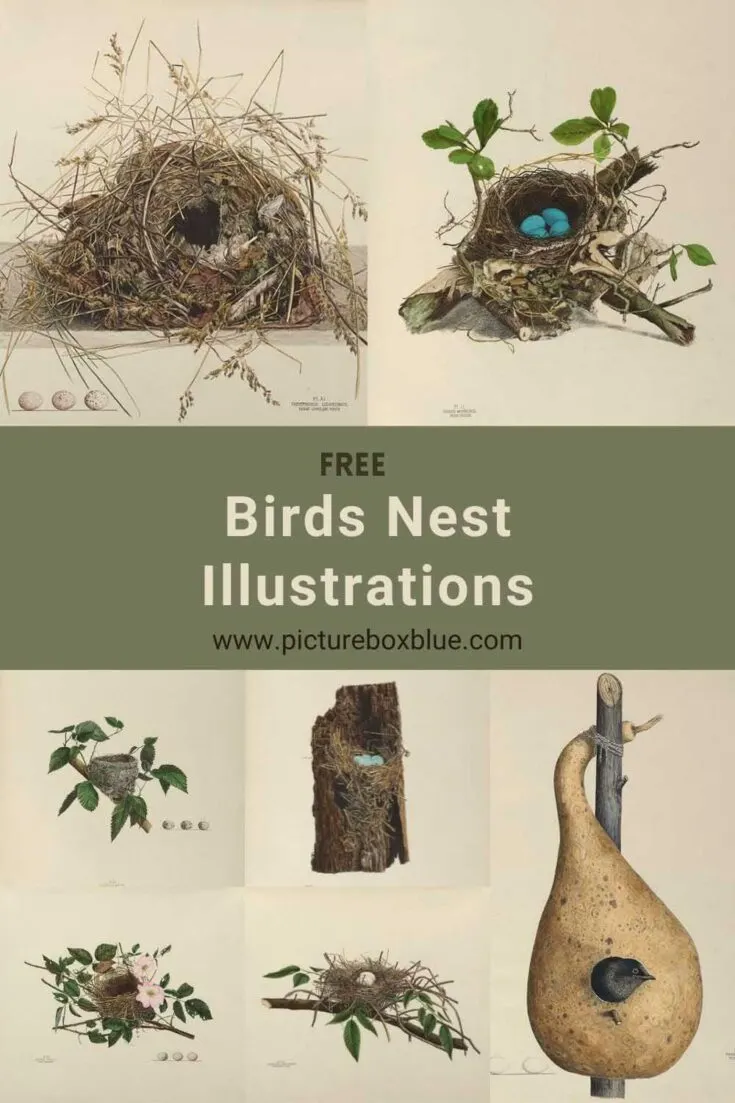
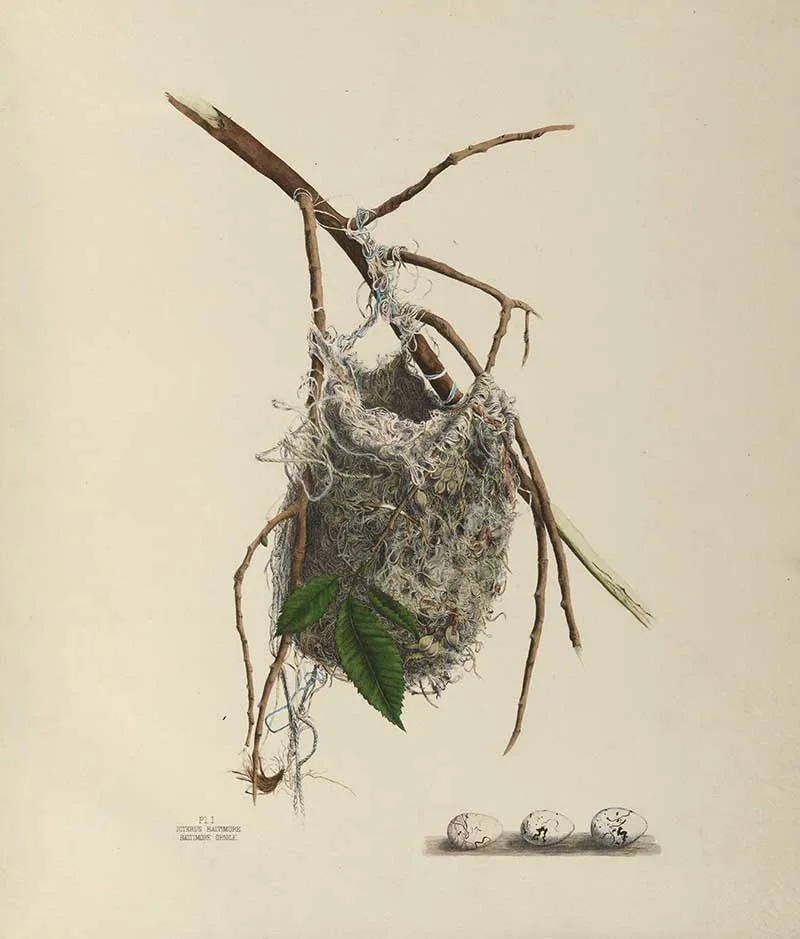

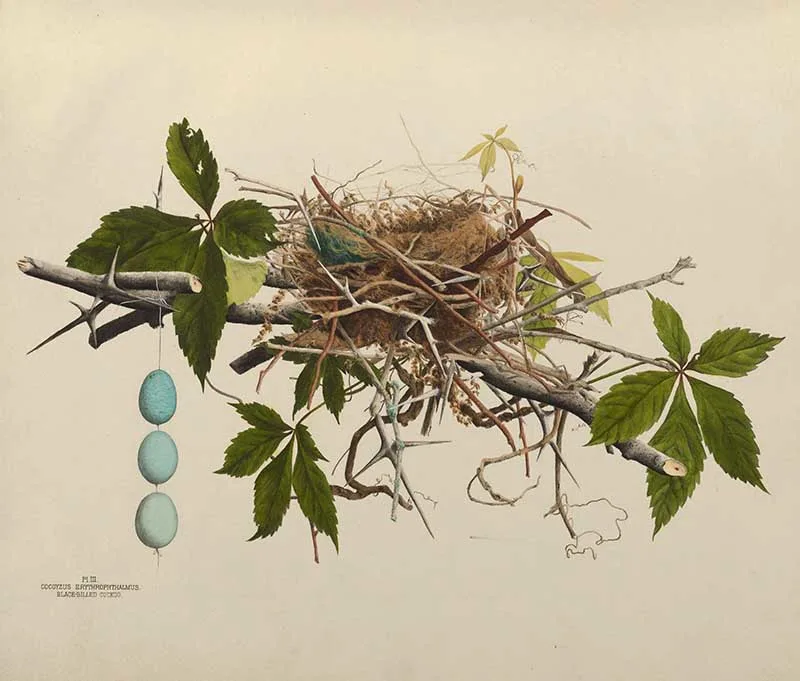
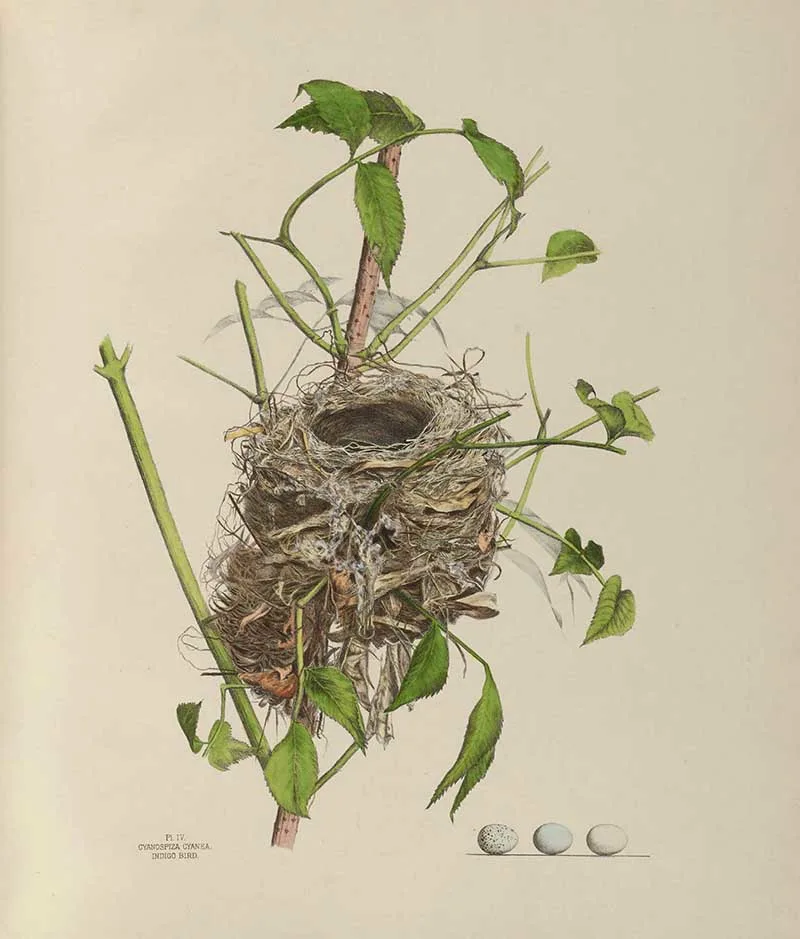
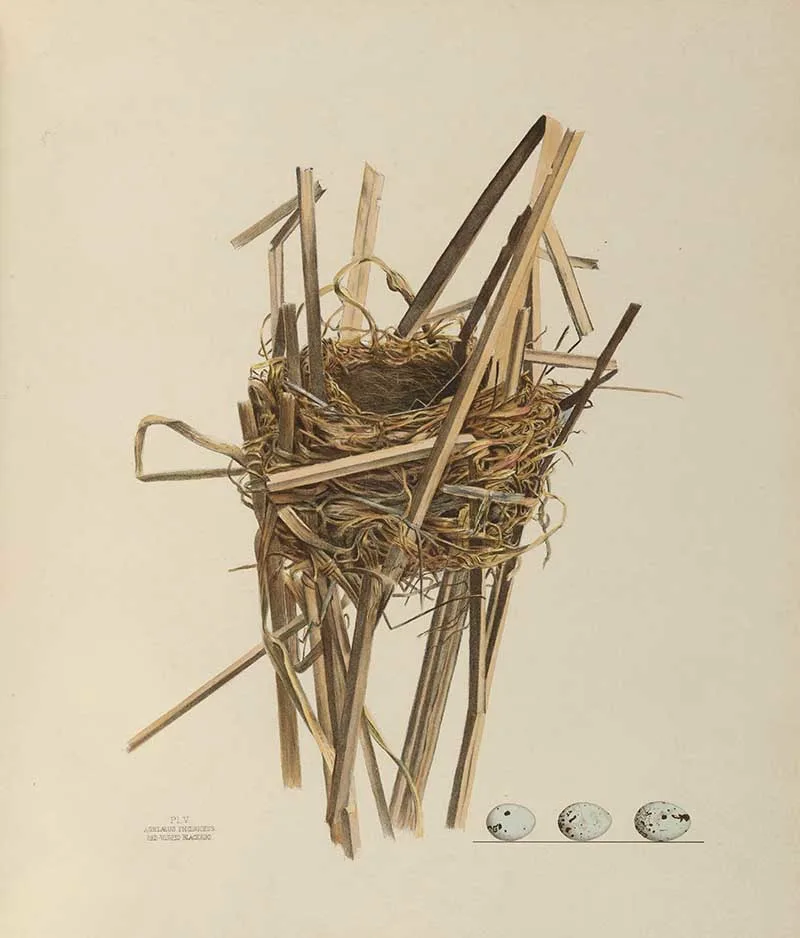
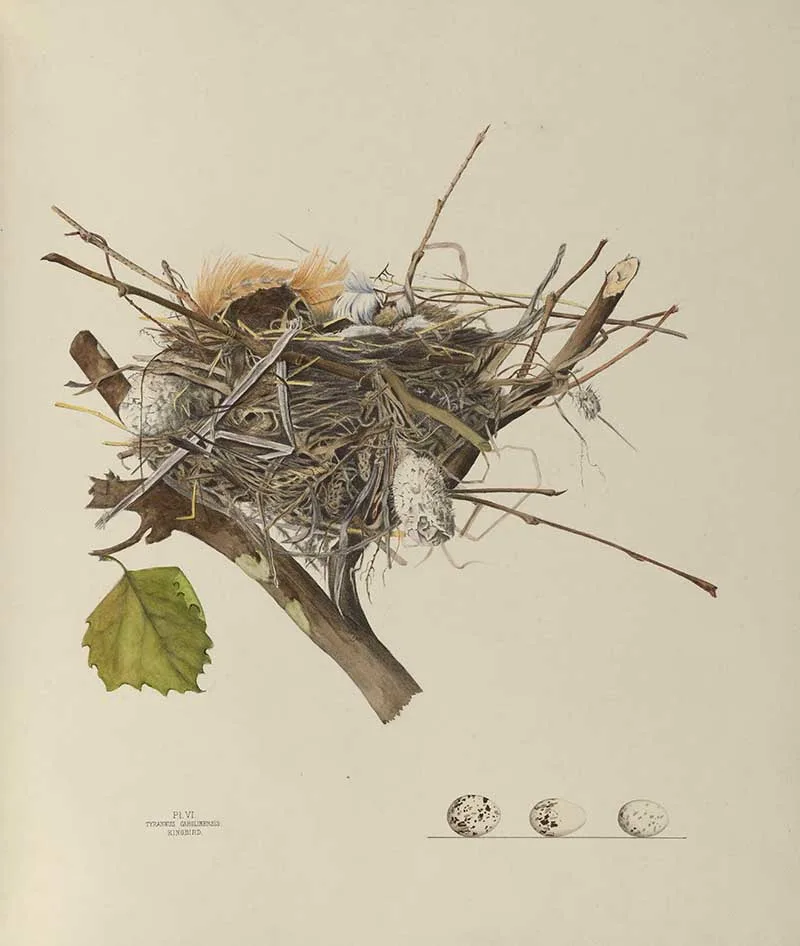
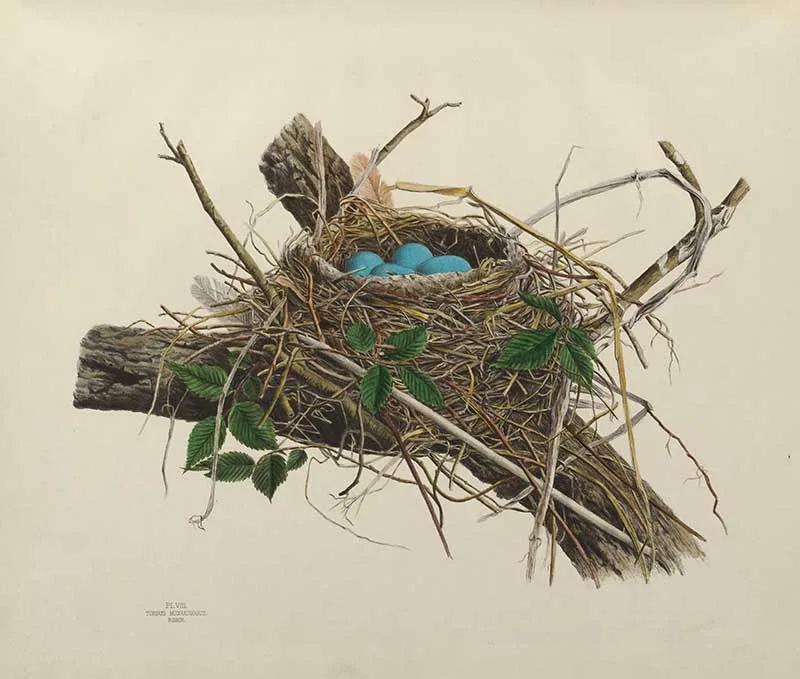
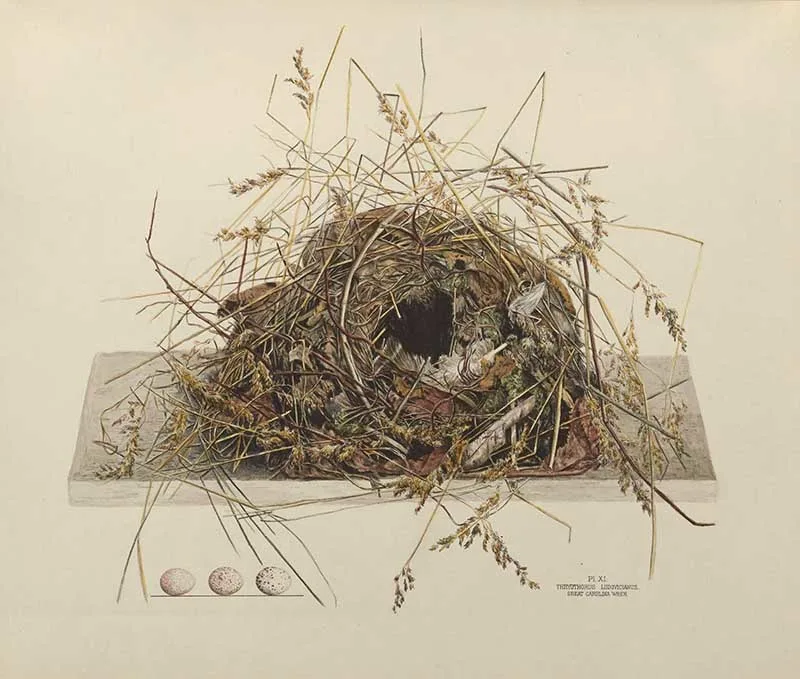
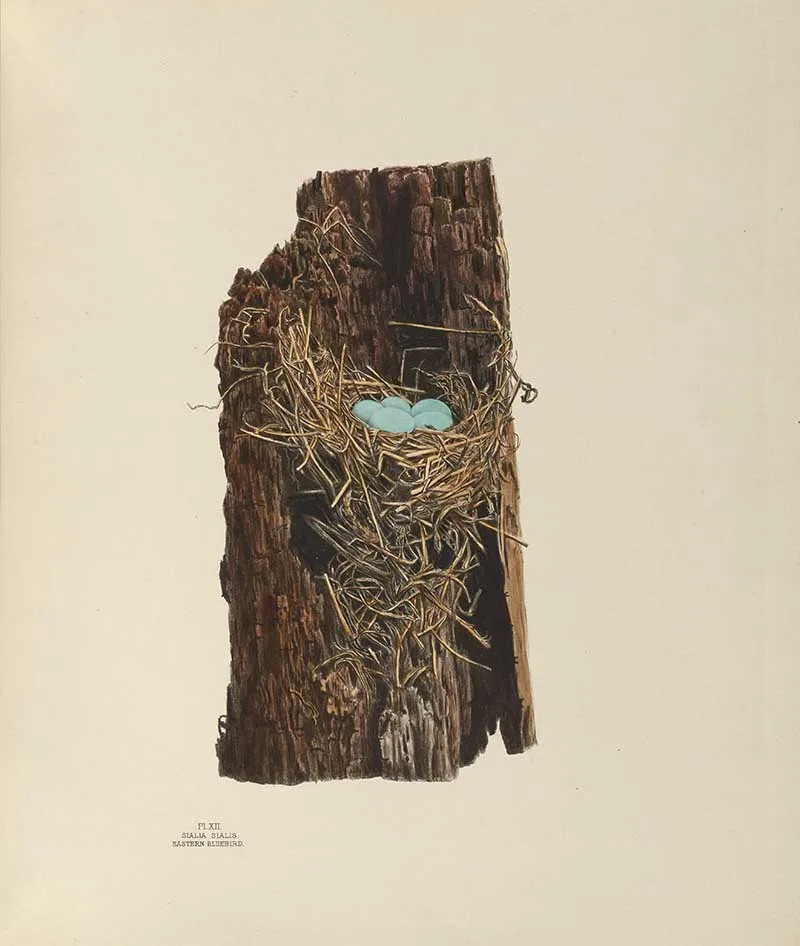
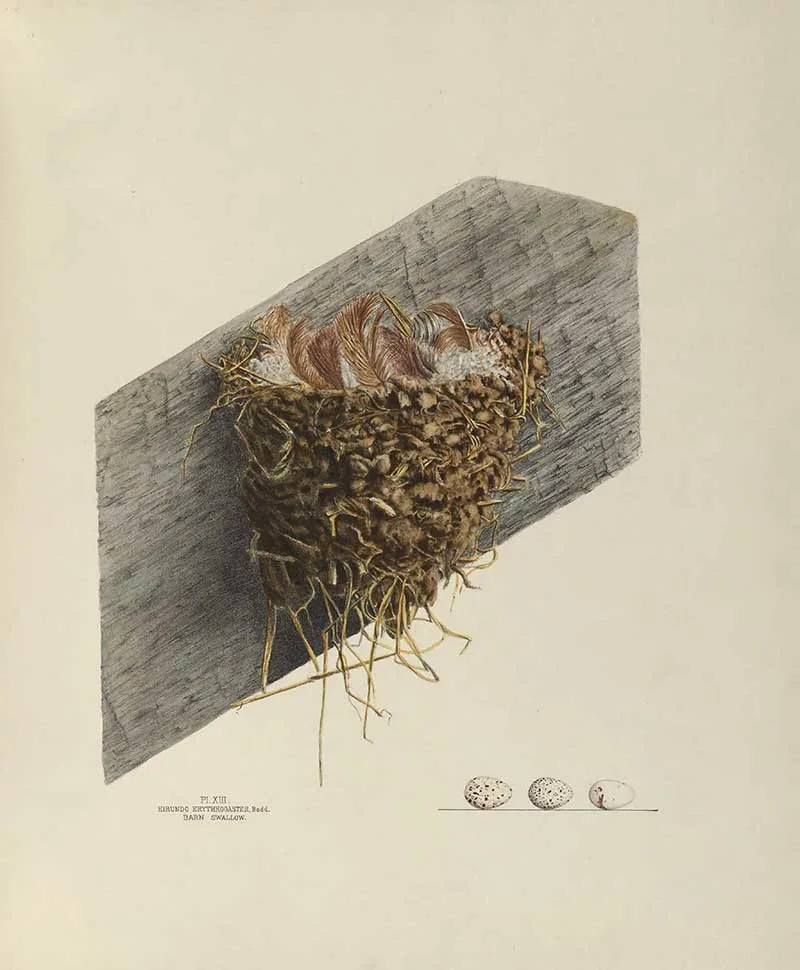
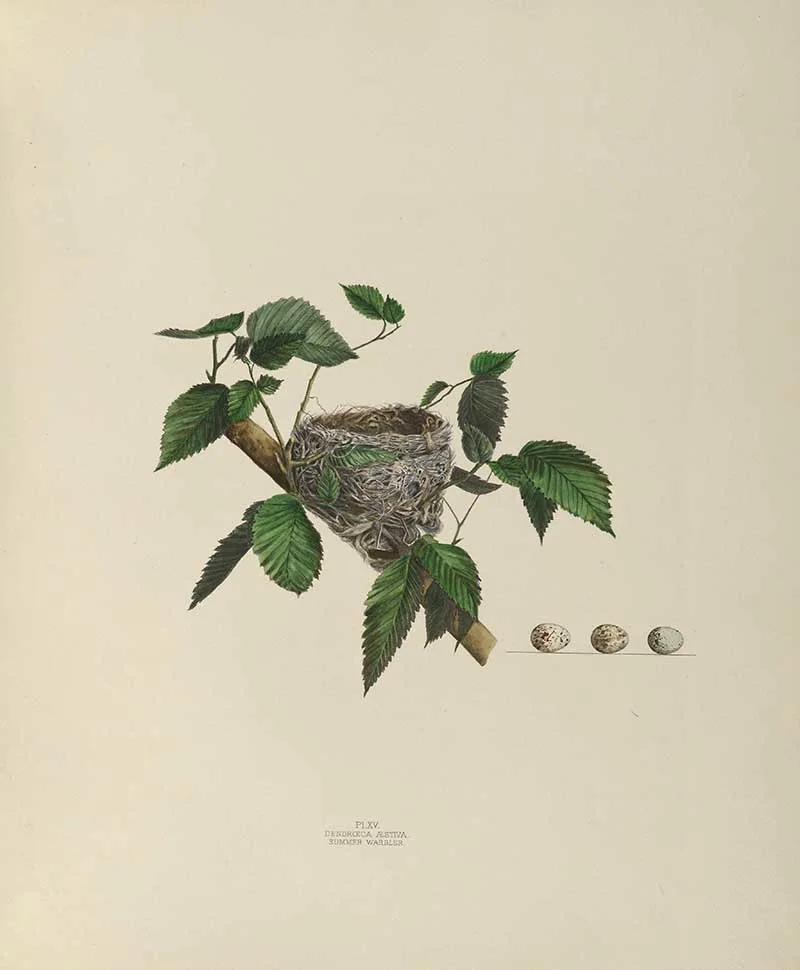
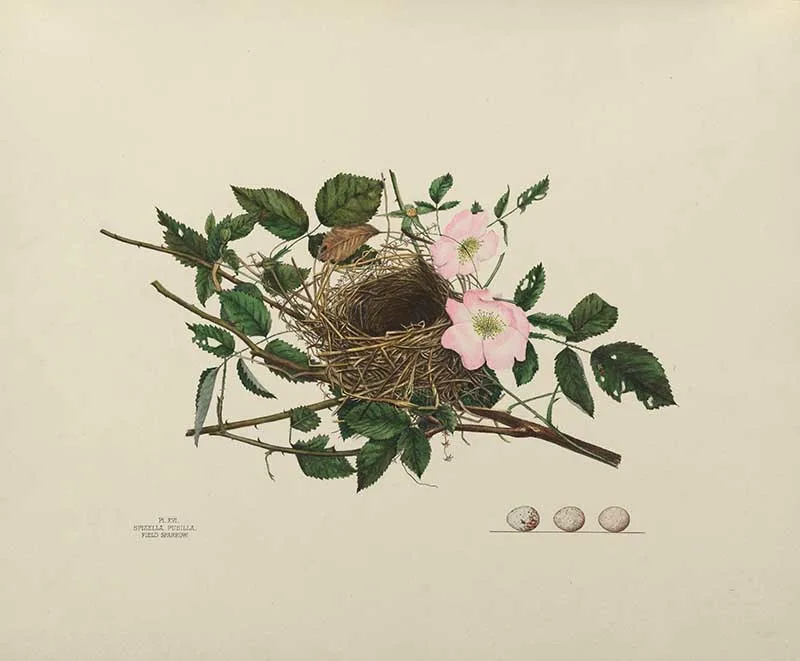
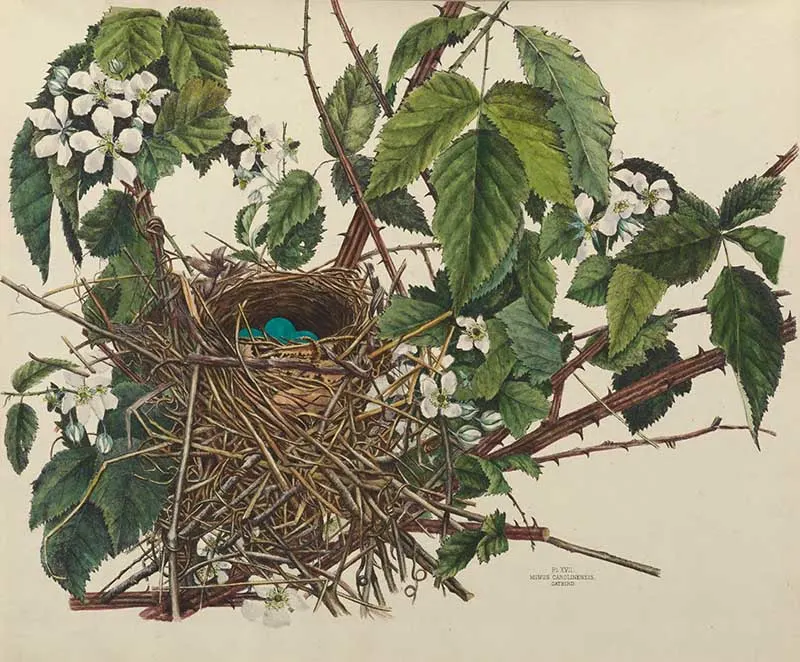
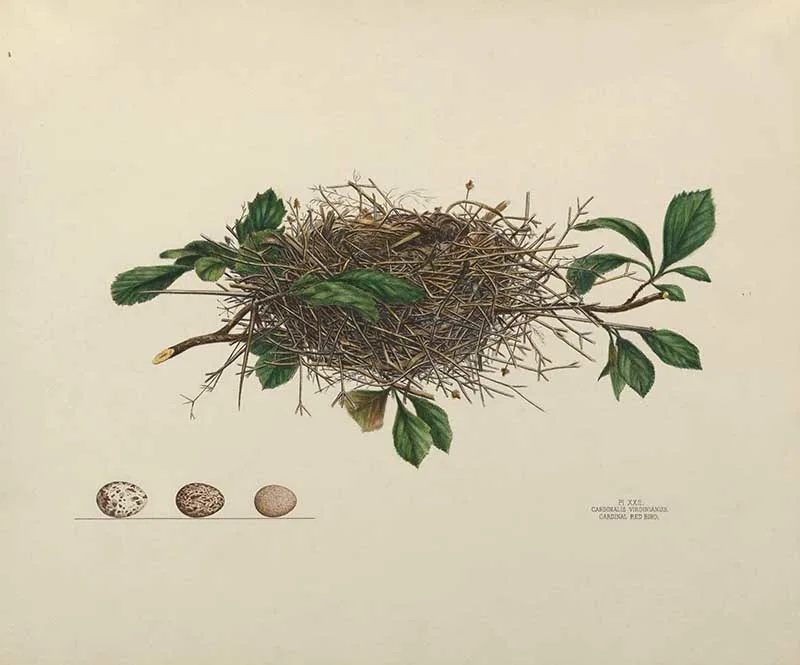
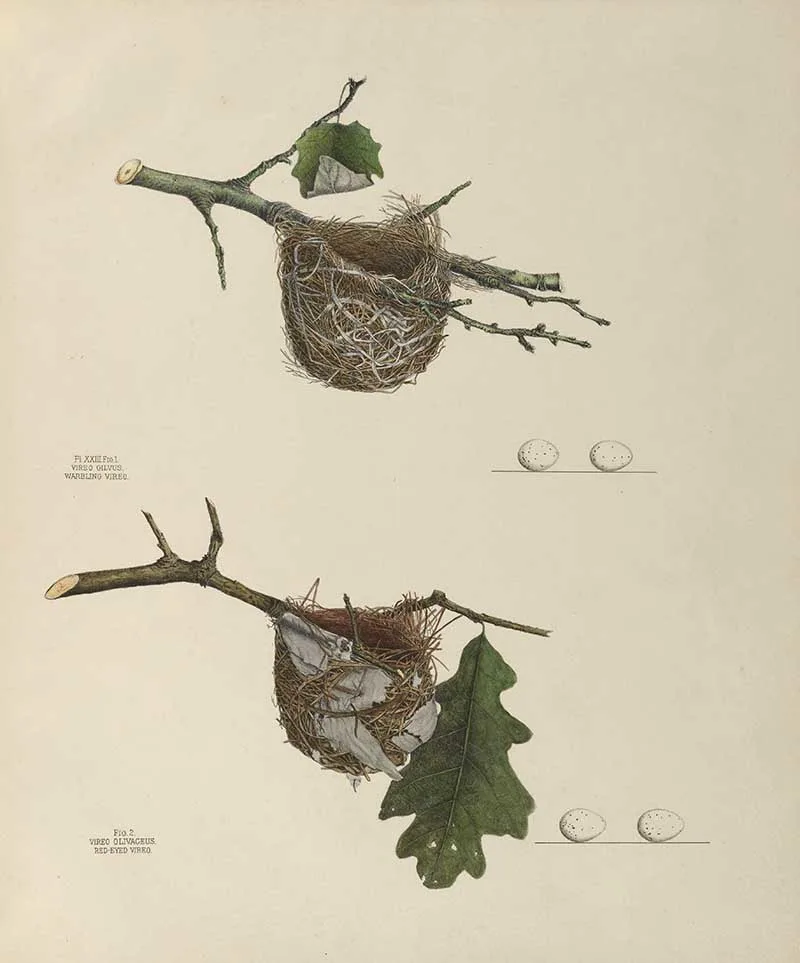
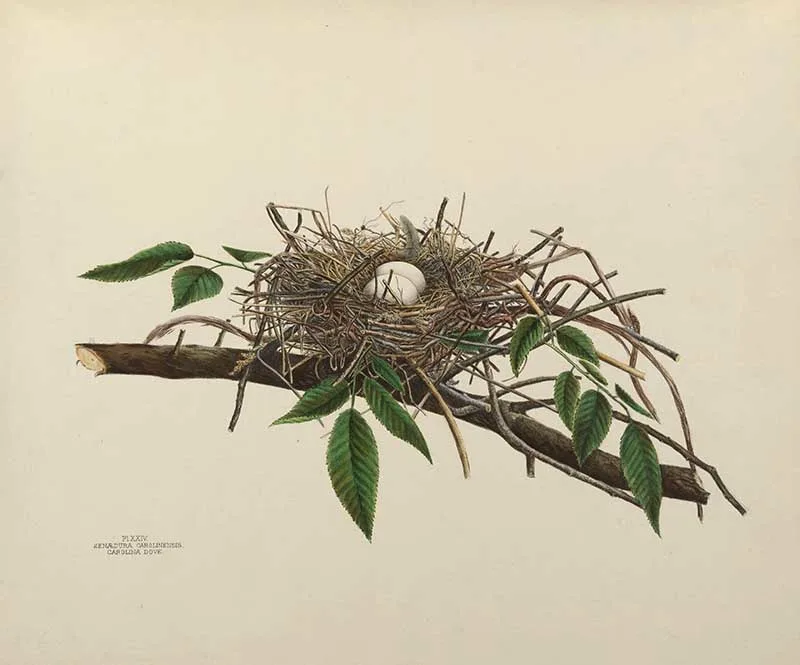
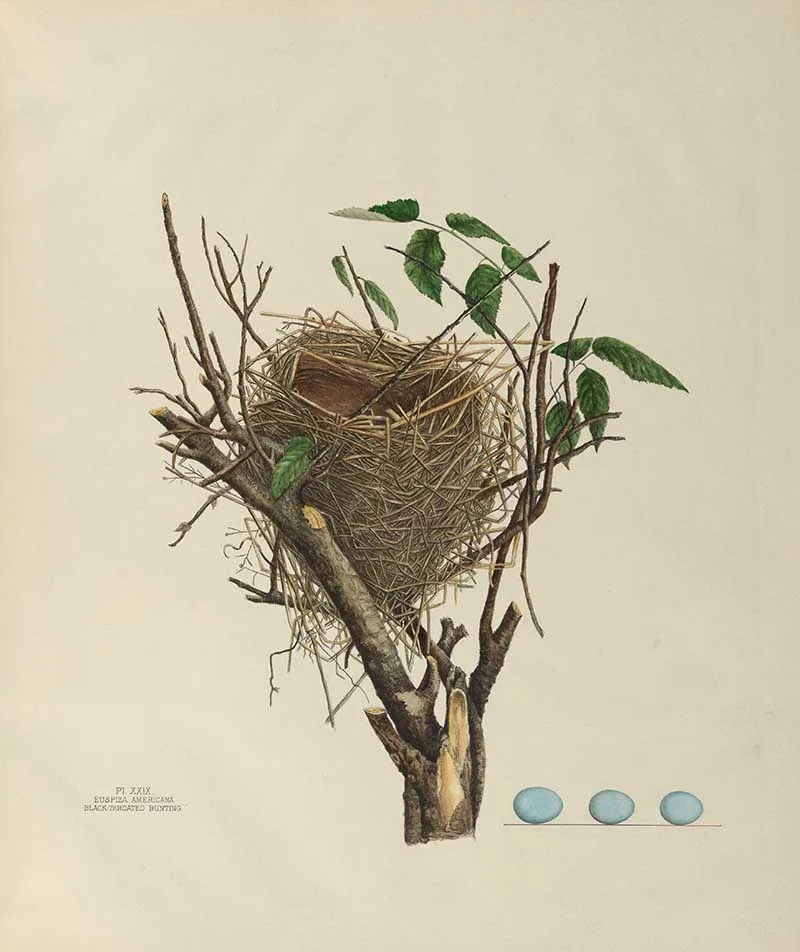
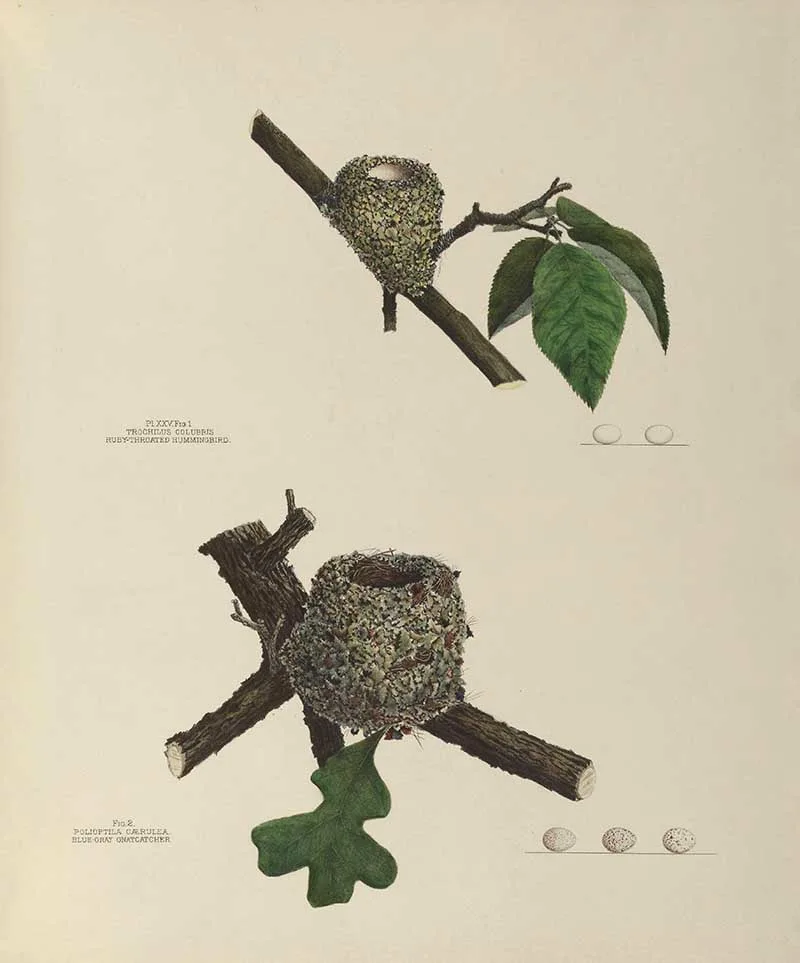
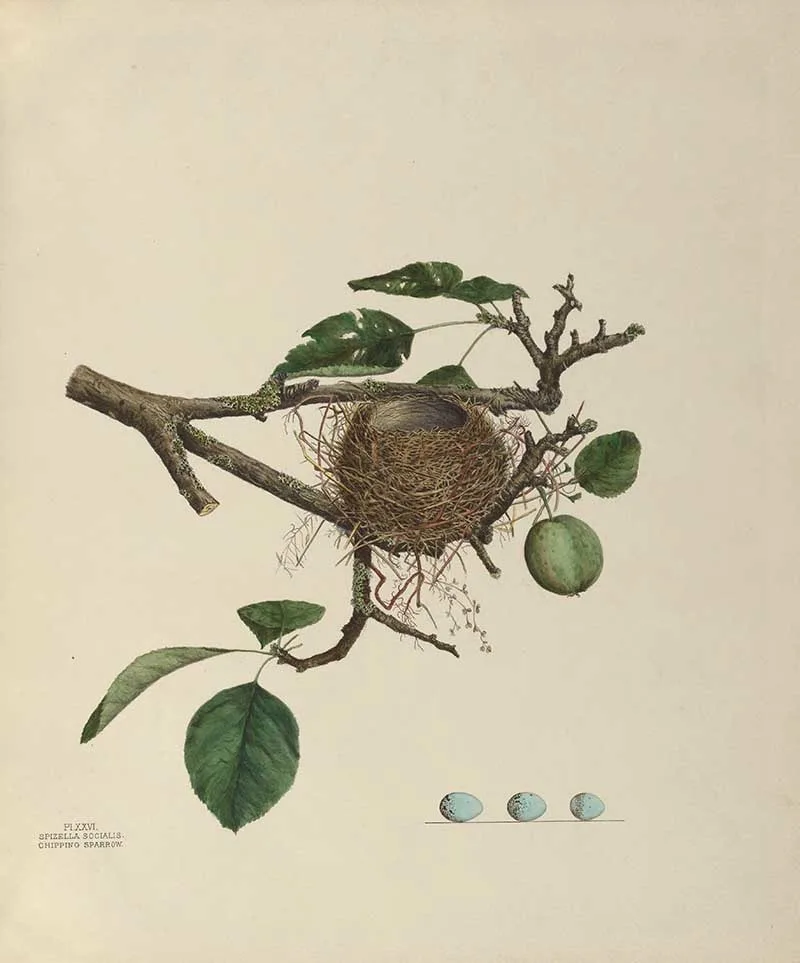
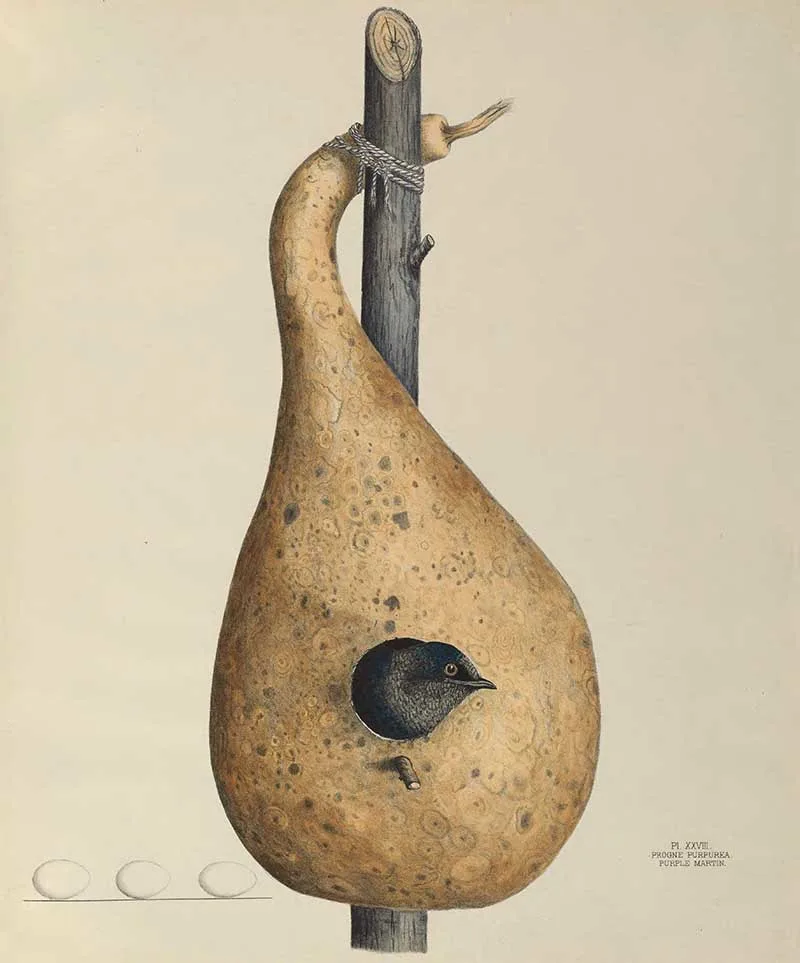
Clare Hamel
Monday 8th of July 2024
Not only are the images wonderful, but the descriptions of where the nest was found and in what type of tree or bush. I love them. One only hopes when the nests were taken , there were no eggs still to hatch
claire
Monday 8th of July 2024
Thank you. I don't know about that but lets hope so, they were painted a long time ago.
MaryEllen
Monday 29th of August 2022
Thank You so much! These are really stunning, and the story that goes with them is heart wrenching. What a talented family!
claire
Tuesday 30th of August 2022
Thank you, yes there are some amazing women and stories with the early Naturalists.
Kathy
Thursday 16th of June 2022
Thank you so much for sharing these wonderful images. The detail in the art and the descriptions of each bird and nest is amazing. Thank you again for sharing these treasures!
claire
Friday 17th of June 2022
Thank you, I'm pleased you enjoyed them they are lovely.
Nina
Sunday 27th of February 2022
As always, I thank you so much for this gift!❤️ I'm from central Ohio and remember seeing some of these birds Your website is educational, fun and decorative. Thank you
claire
Tuesday 1st of March 2022
Thank you so much, it's lovely to hear that you are enjoying the pictures.
Kathy
Saturday 26th of February 2022
The detail on every little twig is amazing! These are beautiful even without the birds.
claire
Tuesday 1st of March 2022
I know they are amazing that's why I had to share them.